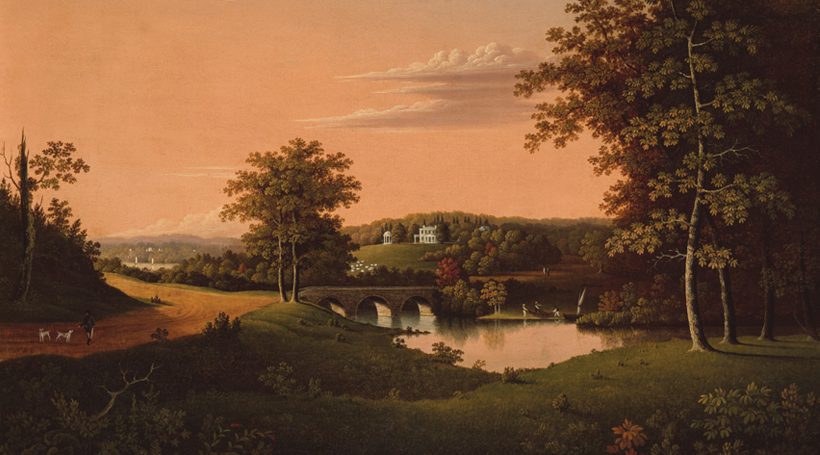Point Breeze, Joseph Bonaparte’s estate in Bordentown
Photo: The Art Institute of Chicago
An elegant mansion built on the bluffs of Bordentown was a crown jewel of early 19th century America. Known as Point Breeze, it housed the largest library of books in the New World and an unparalleled collection of European art. Its famous owner, Napoleon Bonaparte’s brother Joseph, the exiled King of Spain, was considered a good neighbor, permitting townspeople to use the lake for swimming and ice skating.
The estate, which exchanged hands multiple times over the centuries, was last owned by Divine Word Missionaries, which purchased the property in 1941 and kept it as a seminary until a few years ago. When the group announced intentions to sell the property, developers swooped in with big plans, including one to turn the historic land into a warehouse.
That deal was averted. After an agreement was struck between the city of Bordentown, the New Jersey Department of Environmental Protection and a Princeton-based land trust to purchase the estate for $4.6 million, the property is now in public hands. While some 60 acres have been turned over to the state to be converted into a park, the missionary’s buildings will become Bordentown’s new municipal complex. And the last structure still standing from Bonaparte’s time will soon house a museum.
“My biggest accomplishment and my legacy is the fact that the Divine Word fathers let us buy the land,” says James Lynch, who was mayor at the time of the purchase. “It would be criminal to have this historic land taken from us.”

An archeological dig site at Point Breeze. Photo: D&R Greenway Land Trust
“What’s really fascinating about this property is all these layers of history. It goes back 13,000 years to when the Native Americans were along the bluffs here.”
And it almost happened. Developers were offering a significant amount of money, more than what was eventually paid for the property, Lynch says. But in the end, “they turned it down. One of the fathers said they wanted to return it to the way they found it.”
Today, not much is left of the original manor. The lush gardens and the lake have since turned back into marshlands. All the elegant buildings have been demolished, except for the gardener’s house, which is being transformed into the museum expected to open this spring.
It will house artifacts from Joseph Bonaparte’s time, including maps of the period, letters exchanged between the Bonaparte brothers, utensils, dishes, banners and flags, says Linda Mead, president and CEO of D&R Greenway Trust. Greenway will be managing the museum with support of docent-led tours from the Bordentown Historical Society. Most of the artifacts to be exhibited are from the collection of Peter Tucci, a local historian.
“We have one room that will be the Bonaparte salon,” Mead says. “Another room will be dedicated to the natural world, and an ecology room will show the plants and animals, the Delaware River and the birds on the property.”
The picturesque land inspired Bonaparte to build his estate on the banks of the Delaware. The exiled king was smuggled on a ship that traveled from the Old World to New York and then Philadelphia, says Lynch.

Joseph Bonaparte. Photo: Wikimedia Commons
“Bonaparte wanted to buy property in New Jersey, but back then the United States didn’t allow foreigners to buy any property,” says Lynch. “So he had it bought under another name. Eventually, New Jersey changed its laws and he was able to become the owner.”
Point Breeze was modeled after European estates, with its lavish gardens and statues. Bonaparte, who also had a home in Philadelphia, considered the South Jersey mansion his country getaway. Aside from the White House in Washington, D.C., it was the largest manor house in America until it burned down one evening while Bonaparte was out of town.
“He was coming back by horse carriage one night and the entire estate was in flames,” says Lynch. “The story is that when he pulled up, the roof collapsed and everything was pretty much demolished. But the residents of Bordentown had removed all his art and valuables before they could burn.”
This civility astounded Bonaparte. He was so appreciative that, when he eventually left Bordentown, he gave a solid gold chalice to Bordentown’s St. Mary’s Church, which still houses it to this day, Lynch says.
The burning of his mansion wasn’t the reason Bonaparte left. He actually re-built on the property, and the newer mansion was just as lavish as the first. This one had tunnels that connected the property to the river, so supplies could be brought up the river from Philadelphia. But Bonaparte also saw the tunnels as a way to escape if the British ever came looking for him, says Lynch.
The Bordentown years were the happiest of Joseph Bonaparte’s long life, according to historian Patricia Tyson Stroud. He hosted politicians, diplomats, artists, famous authors and naturalists at the estate. “Everyone from former President John Quincy Adams to the Marquis de Lafayette to Mexican revolutionaries visited Joseph Bonaparte and solicited his counsel,” Stroud says.
Another of his famous friends was John James Audubon, the great bird illustrator who raised awareness about conservation through his drawings. Audubon drew sketches of birds during stays at the estate, says Mead.
Eventually, Bonaparte returned to Italy, to his wife and daughter who had stayed behind during his exile. He died soon after, and his New Jersey estate was passed down from generation to generation and eventually sold to Divine Word, with only a few historic relics lasting until today.
When the museum opens in the spring, visitors will have access to the estate’s 60 acres that will be turned into a park and community garden.
“What’s really fascinating about this property is all these layers of history,” says Mead. “It goes back 13,000 years to when the Native Americans were along the bluffs here. They really cared for the property and that stewardship philosophy drew Joseph Bonaparte to the land. Visitors can enjoy the renovated museum with its exhibits about the time and can come work in the gardens, growing vegetables to benefit the community.”














